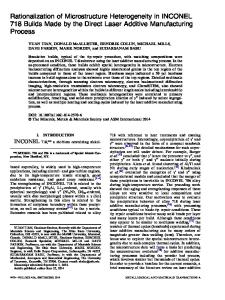Additive Manufacturing by Laser Cladding: State of the Art
In additive manufacturing through laser cladding, 3D objects can be deposited on various substrates through the employment of a high-power source. Depending on the deposited material and on the laser settings, a clad with height from 50 μm to 2 mm can be
- PDF / 25,563,746 Bytes
- 444 Pages / 439.43 x 683.15 pts Page_size
- 61 Downloads / 455 Views
Laser Cladding of Metals
Laser Cladding of Metals
Pasquale Cavaliere Editor
Laser Cladding of Metals
Editor Pasquale Cavaliere Department of Innovation Engineering University of Salento Lecce, Italy
ISBN 978-3-030-53194-2 ISBN 978-3-030-53195-9 (eBook) https://doi.org/10.1007/978-3-030-53195-9 © Springer Nature Switzerland AG 2021 This work is subject to copyright. All rights are reserved by the Publisher, whether the whole or part of the material is concerned, specifically the rights of translation, reprinting, reuse of illustrations, recitation, broadcasting, reproduction on microfilms or in any other physical way, and transmission or information storage and retrieval, electronic adaptation, computer software, or by similar or dissimilar methodology now known or hereafter developed. The use of general descriptive names, registered names, trademarks, service marks, etc. in this publication does not imply, even in the absence of a specific statement, that such names are exempt from the relevant protective laws and regulations and therefore free for general use. The publisher, the authors, and the editors are safe to assume that the advice and information in this book are believed to be true and accurate at the date of publication. Neither the publisher nor the authors or the editors give a warranty, expressed or implied, with respect to the material contained herein or for any errors or omissions that may have been made. The publisher remains neutral with regard to jurisdictional claims in published maps and institutional affiliations. This Springer imprint is published by the registered company Springer Nature Switzerland AG The registered company address is: Gewerbestrasse 11, 6330 Cham, Switzerland
Preface
Laser cladding (LC) for additive manufacturing is a very interesting process for both the production industry and research. Today, LC challenges process engineers and material scientists with many adjustable processes and material parameters, metallurgy, and defects. The development of laser cladding with its unique advantages will continue to advance with additive manufacturing of complex functional and volumetric parts. Additive manufacturing through laser cladding is a nonlinear process depending on many variables. Many models have been developed in order to predict the optimal cladding properties as a function of the fundamental processing parameters governing the deposition. The online continuous process monitoring is fundamental for the final quality of the laser cladded structures. Although laser cladding process is currently well controlled from a manufacturing strategy point of view and allows producing healthy components with a low or nonexistent porosity level, the microstructure of the parts obtained by these techniques is far from being understood and controlled. In metals, the grain size and orientation are essential factors for the control of the properties, especially the mechanical properties. The type of solidification (columnar or equiaxed) and grain size depend on the local soli











